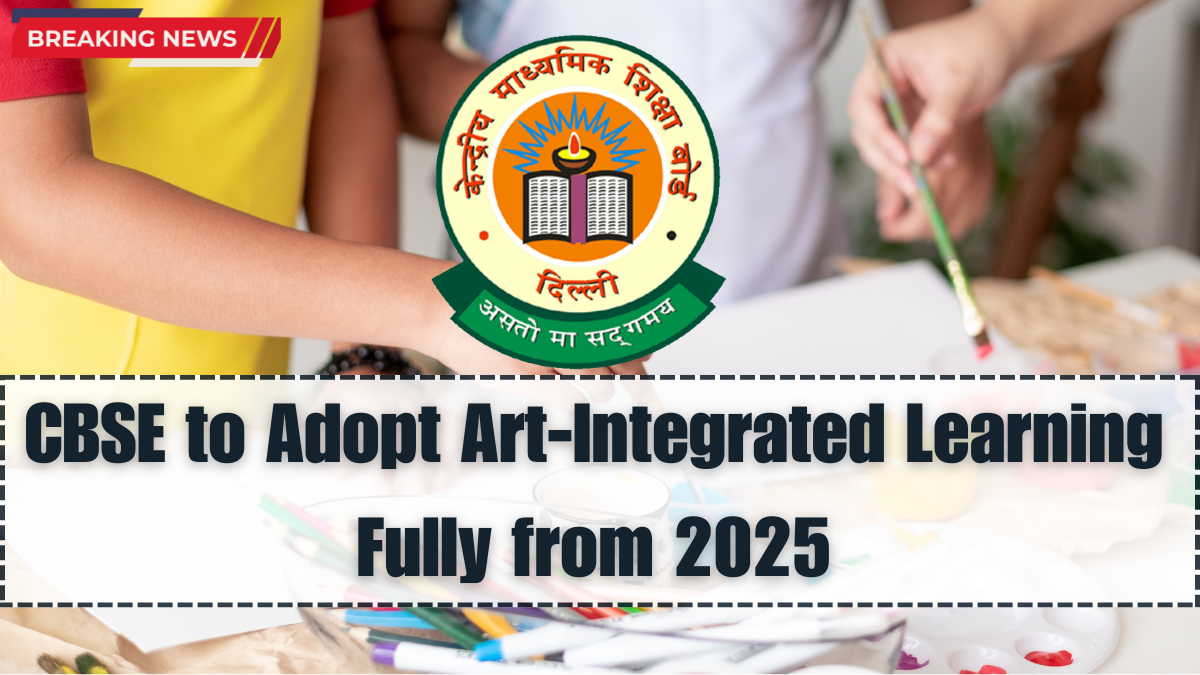The Central Board of Secondary Education (CBSE) has officially declared that Art Integrated Education 2025 will now be a core part of the school curriculum for Classes 1 to 12. Starting from the 2025 academic session, all CBSE-affiliated schools across India are required to implement art-based teaching methods across subjects, aligning with the National Education Policy (NEP) 2020.
The Art Integrated Education 2025 initiative is a shift from traditional rote learning to experiential, creative, and student-centered education. It encourages schools to use music, dance, drama, painting, storytelling, and craft to teach concepts across all subjects, making learning more relatable, enjoyable, and effective.

Objectives Behind Art Integrated Education 2025
The main aim of Art Integrated Education 2025 is to promote creativity, collaboration, and cultural appreciation among students. CBSE believes that art is not just an extracurricular activity, but a powerful teaching tool that enhances understanding, emotional intelligence, and communication skills.
Key goals of the initiative include:
-
Making learning more engaging and conceptually strong
-
Encouraging students to express themselves freely through art forms
-
Enhancing critical and creative thinking through interdisciplinary methods
-
Developing respect for Indian culture, heritage, and diversity
-
Aligning school education with NEP’s vision of holistic development
With the introduction of Art Integrated Education 2025, CBSE aims to foster well-rounded individuals equipped with both academic and emotional intelligence.
How Art Will Be Integrated Across Subjects
Under the Art Integrated Education 2025 framework, art will be used as a medium to teach and evaluate concepts across science, mathematics, languages, and social studies. This integration helps students connect theoretical learning with real-life experiences.
Examples of art-based learning activities:
-
Maths: Measuring shapes through craftwork and origami
-
Science: Explaining water cycles through drawings and storytelling
-
Social Science: Enacting historical events through drama or roleplay
-
Languages: Writing and reciting poems, scriptwriting, puppetry
-
EVS: Creating posters on environmental issues using collage techniques
Schools are encouraged to use regional art forms and ensure that students actively participate in group projects, thereby developing teamwork and empathy under Art Integrated Education 2025.
CBSE Guidelines for Schools and Teachers
To support the effective implementation of Art Integrated Education 2025, CBSE has issued structured guidelines for schools. These include training modules, lesson plans, assessment rubrics, and project documentation templates.
CBSE mandates for schools:
-
Minimum two art-integrated projects per student annually (Classes 1–10)
-
Interdisciplinary projects using two or more art forms
-
Integration of local and tribal art to promote cultural awareness
-
Teachers to undergo online and offline training workshops
-
Evaluation to be based on creativity, teamwork, effort, and understanding
The Art Integrated Education 2025 will be a compulsory component of the internal assessment system and will contribute to final grades, especially in Classes 9 and 10.
Benefits of Art Integration in Education
Experts believe the Art Integrated Education 2025 policy is a game-changer in improving student motivation, retention of concepts, and classroom participation. The initiative supports children with different learning styles, especially visual and kinesthetic learners.
Major benefits include:
-
Encourages multi-sensory learning for deeper understanding
-
Improves focus, concentration, and memory
-
Helps in early identification of student talents and interests
-
Promotes inclusive learning environments
-
Reduces academic pressure and boosts emotional well-being
By treating art as a pedagogical tool and not just an extracurricular activity, Art Integrated Education 2025 is helping transform classrooms into joyful spaces of learning and creativity.
FAQs
What is Art Integrated Education 2025?
Art Integrated Education 2025 is a CBSE initiative that makes art a compulsory part of learning by integrating it with the teaching of academic subjects.
From which class is art integration mandatory?
The Art Integrated Education 2025 policy applies to all students from Class 1 to Class 12 across CBSE schools.
Will it affect the exam pattern?
While traditional exams remain, internal assessment will now include art-integrated projects and activities under the Art Integrated Education 2025 guidelines.
Are teachers trained for this new approach?
Yes, CBSE has launched training programs and modules to help teachers implement Art Integrated Education 2025 effectively.
What type of art forms can be used?
Schools can use a variety of Indian and global art forms including music, dance, painting, sculpture, drama, crafts, and local folk arts as part of Art Integrated Education 2025.
Click here to know more.
